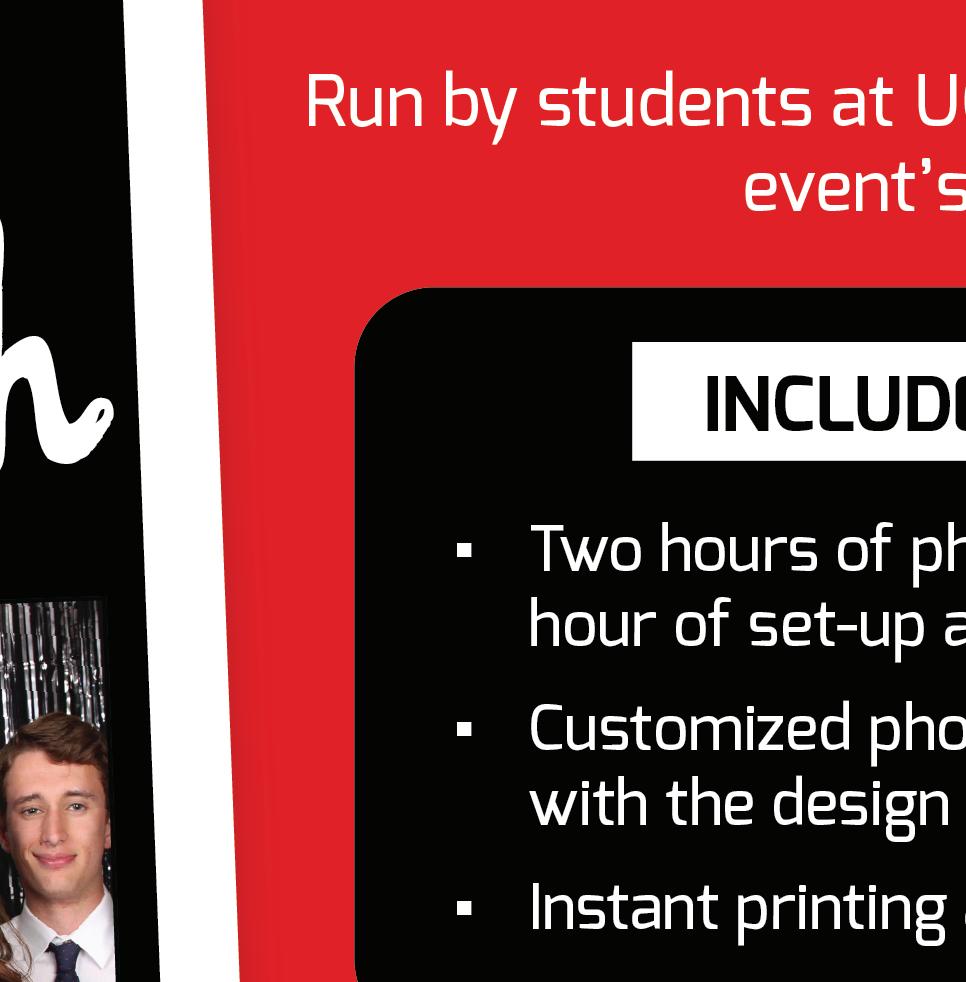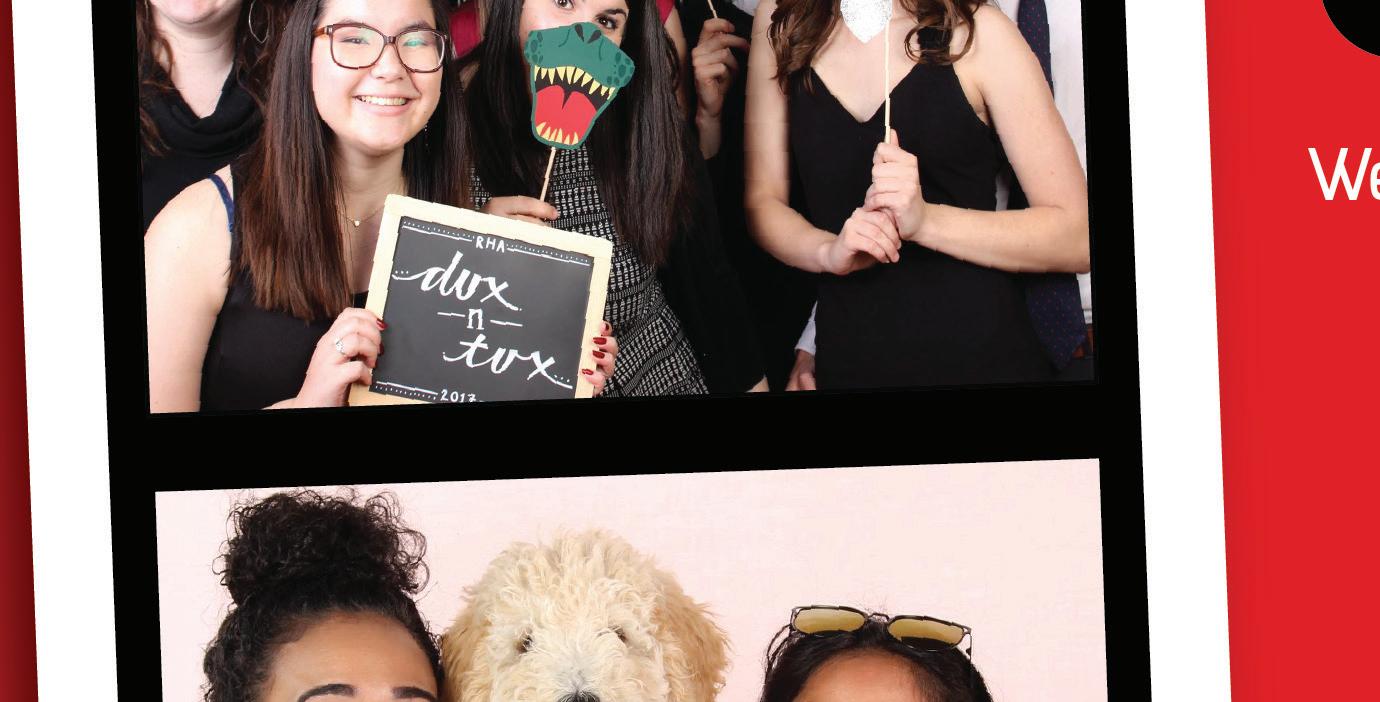CHECK INSIDE FOR UO Students
express themselves through back-toschool fashion
OPINION


MONDAY, NOV. 10, 2025





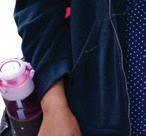




CAMPUS CLUBS







express themselves through back-toschool fashion
OPINION


MONDAY, NOV. 10, 2025





















Kahl: Big Brother might not be watching anymore, but his contract is still in place
Emma Kahl Opinion Columnist
The fi rst time I heard about Flock cameras was when I was handed a small flyer while walking through downtown Eugene this summer. The words “mass surveillance” immediately stood out on the page.
Eugene City Manager Sarah Medary signed a two-year contract with Flock Security back in March. The automatic license plate readers were quickly installed by May, and just five months later, were shut down by Medary on Oct. 14.
The cameras have been a huge source of controversy for months, as this surveillance is both an invasion of privacy and a breach of local safety. With increasing Immigration and Customs Enforcement arrests in the local area, ICE’s history of accessing data from Flock and Flock’s new partnership with Amazon’s Ring doorbell, there’s potential for these cameras to have a wide-reaching impact on the Eugene community.
Continue
Clubs called upon administration to realize The South Asian, Southwest Asian and North African Center’s new space as extension to the Multicultural Center.
By Sasha Love Senior News Reporter
The South Asian, Southwest Asian and North African Center has found its home in the Erb Memorial Union after the University of Oregon administration was called upon to establish the cultural center.
Last spring, several student cultural organizations delivered a letter to Johnson Hall requesting the establishment of the new center. After a summer of interviews and paperwork, room 211 is now fi lled
Despite newly cut benefits, the community has rallied to meet yearly increasing food needs.
with colorful rugs, warming teas and a place to build community.
SSWANA’S grand opening celebration is happening on Jan. 15.
“Our biggest goal is to give anyone within the SSWANA region a place that kind of feels like home. And anyone who wants to learn about the region as well.
I think we hope it’s a really immersive space,” SSWANA Center Engagement Fellow Rayna Patel said.
Patel hopes to host henna hours, have ethnic teas and show culturally significant movies in the center.

By Maria Weyne, Mikayla Mesko and Joy Edwards PDX Reporters
On Oct. 28, President Donald Trump announced cuts to the Supplemental Nutrition Assistance Program during the ongoing government Shutdown, eliminating funds for the month of November. The cuts would affect over 140,000 Portland residents relying on food assistance programs.
The Portland community, however, came together, with over 30 businesses offering free or discounted meals for SNAP recipients, local businesses and nonprofit organizations collecting donations and fundraising efforts by individuals before October ended.
Heretic Coffee was one of the fi rst to announce their SNAP breakfast pro-
gram, with no proof required for the free meal. The coffee shop is a non-profit that works with volunteers to serve the community. It was able to raise over $300,000 to cover breakfast, and now lunch, to anyone in need.
Among others who began collecting donations is Charlie Krause, the founder of Queer Cute. Their original plan was to get canned food and non-perishables dropped off at Queer Cute, though once they realized how many people would be impacted, Krouse switched to monetary donations.
“I was just trying to find immediate support for folks who are losing SNAP,” Krause said. “I realized food drop’s not really gonna cut it, especially with the levels of hunger that we’re seeing, so I decided to do a mutual aid fund instead.”
Krause created an application system for those in need to submit responses, alContinue story on page 7




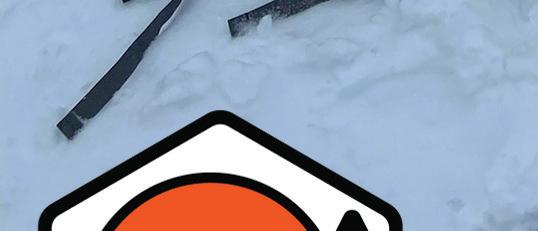




EDITOR IN CHIEF
Tarek Anthony
PRINT MANAGING EDITOR
Ryan Ehrhart
DIGITAL MANAGING EDITOR
Ysabella Sosa
NEWS EDITOR
Reilly Norgren
INVESTIGATIONS EDITOR
Ana Narayan
A&C EDITOR
Claire Coit
SPORTS EDITOR
Jack Lazarus
OPINION EDITOR
Gracie Cox
PHOTO EDITOR
Saj Sundaram
COPY CHIEF
Olivia Ellerbruch
VIDEO EDITOR
Jake Nolan
PODCAST EDITOR
Stephanie Hensley
SOCIALS EDITOR
Ysabella Sosa
VISUALS EDITOR
Noa Schwartz
DESIGN EDITOR
Adaleah Carman
Eva Andrews
DESIGNERS
Ellery Burton-Tillson
Maya Gooneratne
Nina Rose
PUBLISHER AND PRESIDENT
Eric Henry (X317) ehenry@dailyemerald.com
VP OPERATIONS
Kathy Carbone (X302) kcarbone@dailyemerald.com
DIRECTOR OF SALES & DIGITAL MARKETING
Shelly Rondestvedt (X303) srondestvedt@dailyemerald. com
CREATIVE & TECHNICAL
DIRECTOR
Anna Smith (X327) creative@dailyemerald.com
ACCOUNT EXECUTIVES
Torin Chevalier Camcole Pereira Ava Stephanian Elliot Byrne
The Daily Emerald is published by Emerald Media Group, Inc., the independent nonprofit media company at the University of Oregon. Formerly the Oregon Daily Emerald, the news organization was founded in 1900.
Emerald Media Group 1395 University St.,#302 Eugene, Or 97403 (541)-346-5511


UO updated its registration interface, changing how students will register for classes.
By Corey Hoffman Senior News Reporter
The University of Oregon updated its registration portal on Duckweb on Oct. 30 ahead of Winter Term registration.
While the steps students take to register for classes remain the same, “where students click to register and make changes will be different,” according to a UO announcement.
The new registration portal includes five functions: prepare for registration, plan ahead, view registration information, register for classes and browse classes.
The previous version, Schedule Builder, allowed students to add potential classes to a “registration cart” and generate all the schedule options. The new registration portal allows students to create “plans” with their potential classes, but these are limited to three.
Students can use these pre-built plans to register for their courses within


EPD has released a map of automated license plate recognition cameras following the pause of Flock cameras in city.
By Billie Corsetti News Reporter
The Eugene Police Department released a map on Friday that lists all locations of automated license plate recognition cameras in the city.
The map is a photo of locations, but does not list specific addresses. Eyes Off Eugene-Springfield, an advocacy group against mass surveillance, had created their own interactive map prior to this announcement.
In a statement on the City of Eugene’s website, EPD announced that due to the pausing of the
cameras by City Manager Sarah Medary it was not necessary to withhold the locations of the ALPRs.
“With the cameras no longer active the Eugene Police Department has determined that, on balance, withholding their locations is no longer necessary to prevent potential criminal mischief nor to avoid aiding suspects by evading detection,” EPD wrote in the announcement. “In response to these developments, and in alignment with practices adopted by other law enforcement agencies, EPD is opting to publish a map of the ALPR camera locations in the city of Eugene.”
their registration window, similar to the registration cart of the previous portal.
Students now access all registration related materials through the Registration Dashboard. There are three ways to register for classes: registering using a pre-built plan, registering by searching for classes or registering with a CRN.
Due to the changes, UO has tutorials available for students on how to use the new interface on the Office of the Registrar website.
Sophomore Hila Badescu Knal who is studying Linguistics and English and minoring in comic studies, said the updates look “clunky and unusable,” and makes it difficult to plan for the upcoming term.
“I guess the thing that frustrated me the most about the update was that it didn’t really feel like an update at all,” Badescu Knal said. “It’s not like DuckWeb was perfect before, but it was really straightforward and did its job well.”
As a double major, Badescu Knal said the updates are overwhelming and difficult to work with, as it feels like “tools that were useful to me are just gone.”
e University of Oregon did not respond for comment.
Here’s a breakdown of who the changes apply to and next steps. NEWS
By Sasha Love Senior News Reporter
Trillium Health will replace PacificSource as the only designated community care organization for people on the Oregon Health Plan, an Oregon Medicaid system.
This means 92,000 OHP members will be transitioned from PacificSource to Trillium, according to the Oregon Health Authority. This comes after several recent discussions of financial viability between OHA, the entity that manages CCOs, and PacificSource.
In August, PacificSource said it found itself in an $89 million projected deficit for 2025. The insurance company then announced on Oct. 16 that its participation in the Lane County CCO program was not “sustainable.”
OHA is hoping PacificSource will remain in Lane County until Feb. 1 to allow for a 90-day transition window, but PacificSource said in a statement that it will be leaving on Jan. 1.
While students and individuals on the OHP-specific plan will be affected, other types of PacificSource plans — including the UO Student Health Benefits Plan — will not be affected.
“At this time, we are continuing to work with OHA and Trillium regarding transition planning. We will continue to keep our members, partners, and stakeholders informed as
conversations progress,” PacificSource Spokesperson Lauren Thompson said in a statement to The Daily Emerald.
While University Health Services uses PacificSource privately for the student-specific health benefits plan, PacificSource’s OHP is also an in-network provider for UHS.
Margaret Trout, a spokesperson for UHS, said students on OHP will be notified about any changes.
“Students who are PacificSource members through OHP will hear directly about any reassignment to another CCO. If students are reassigned to the other Lane County CCO, Trillium Community Health Plan, they will continue to have coverage for visits at UHS,” Trout said.
Trout also clarified that other private health insurance plans offered by PacificSource that are accepted as in-network at UO will not be affected.
In an October 17 press release, OHA said it is drafting plans with PacificSource and Trillium to create and ensure a “mandatory ‘transition of care’ period, where Trillium would be required to ensure that members have uninterrupted, appropriate access to services previously authorized by their former CCO.”
In the same press release, OHA said it is also planning community forums as the year comes to a close to communicate changes with members.
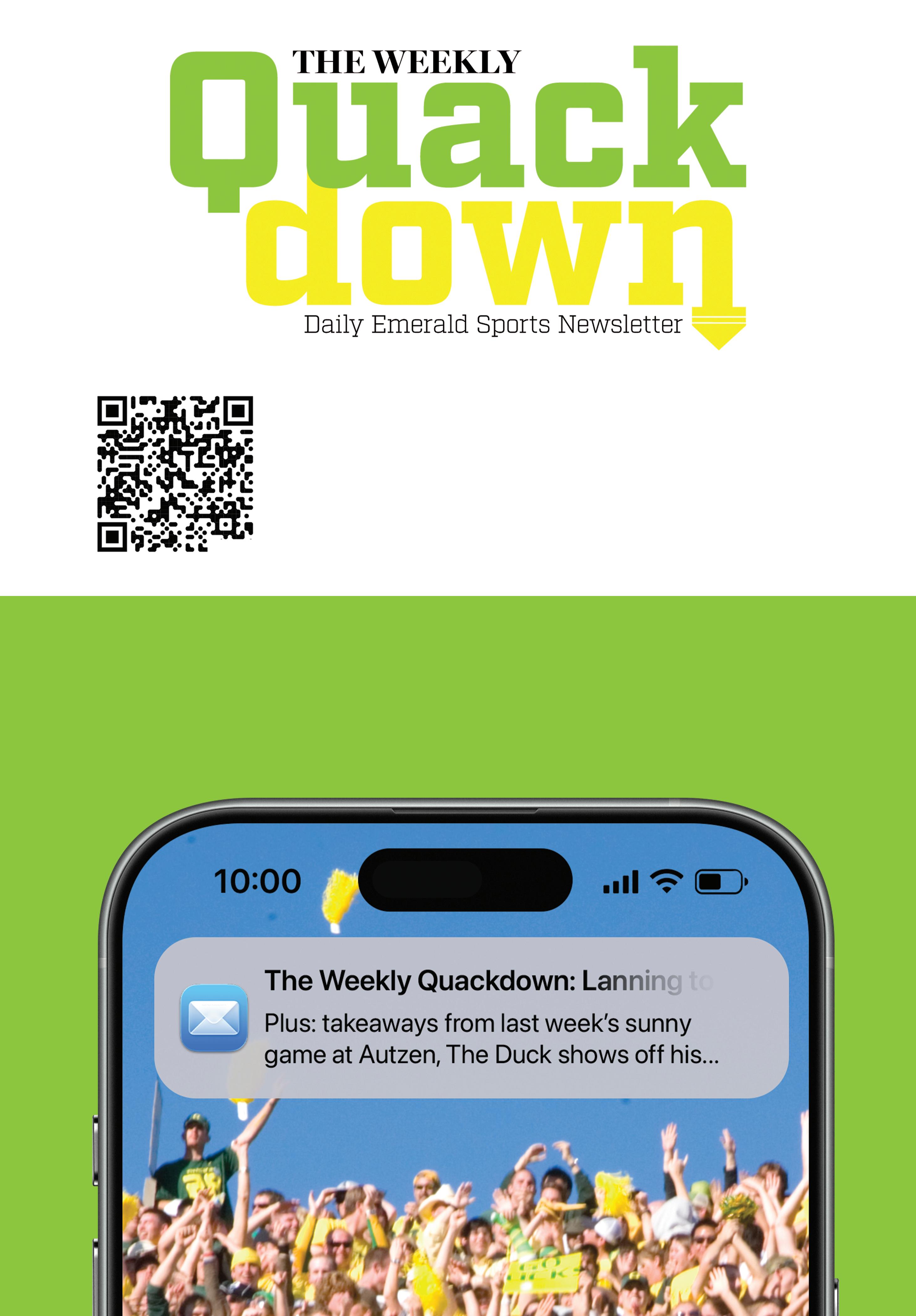

Opinion: As we reach the height of fall term, it is important to raise awareness about the issue of sexual violence on campus.
Maddox Brewer-Knight Opinion Columnist
Sexual assault is a major issue on college campuses and the University of Oregon is, unfortunately, no expectation.
During the 2024-25 school year, 251 students reported incidences of sexual misconduct to UO’s Title IX coordinator, with 38 of these incidences constituting cases of sexual violence.
Even this year, when school had just begun, students received emails about disturbing events unfolding in our community. On Oct. 6, students were alerted about a reported drugging, allegedly carried out through a spiked vape at a fraternity party. On Nov. 3, the university issued two more alerts regarding spiked alcohol and marijuana.
Sadly, such events are not uncommon. Last fall, students were alerted about one report of sexual assault and two reports of drugged drinks — all allegedly occurring at fraternity parties. The school year before, three UO fraternities were suspended in winter term for alleged druggings.
These incidents reveal a pattern of sexual assaults and druggings occurring toward the beginning of a school year. While this might appear to be a coincidence, it is a manifestation of a well-documented phenomenon called the Red Zone.
According to RAINN, an anti-sexual violence nonprofit, the Red Zone is the period between

Emma Kahl is an opinion columnist for the Daily Emerald. She is currently a senior, majoring in written journalism and minoring in global studies. Her writing focuses on social commentary, culture and politics.
freshman move-in and Thanksgiving break when 50% of all sexual assaults on college campuses are reported.
Students are especially vulnerable at this time while navigating new experiences like living on their own, attending parties and experimenting with alcohol and drugs. Students are also at increased risk before making close friends to rely on in these settings.
Though all students are at an increased risk of experiencing sexual violence, freshman women are statistically the most affected group.
As incoming freshmen, UO students are required to complete an online sexual assault prevention module, as well as courses on alcohol, drugs and safety to prepare for life in their new college environment.
The system fails to acknowledge the rapidly updating techniques sexual predators use to take advantage of their victims, with perpetrators now allegedly using items like spiked vape pods and marijuana that people might not question compared to an open container.
In many campus settings, the Red Zone isn’t explicitly addressed at all.
“I am both a sorority member and an RA, and I haven’t really seen any specific initiatives to raise awareness about the Red Zone,” UO junior Ella Kuhn said. “I think the most I’ve seen is putting up posters as an RA.”
Despite the lack of direct education, Kuhn
identified the many safety resources provided to students.
UO Resident Assistant Amaya Caricaburru said this oversight is cause for concern.
“It would be helpful if we were given some concrete information about the Red Zone and how to party safely to give out to our residents,” she said.
As the Red Zone reaches its zenith, I urge students, particularly freshmen, to stay vigilant. There is nothing that we can do to guarantee our own safety, as the onus of sexual assault rests solely on the perpetrator, but we must take precautions to protect our community.
When attending parties, find a trusted friend to stick with, leave if you feel uncomfortable and be wary about accepting things from others. Take advantage of the university’s resources, like the Duck Rides program or a self-defense workshop at the Rec.
By raising awareness about the Red Zone and sexual violence on campus, we can work toward creating a safe college community for all.

Maddox Brewer Knight is an opinion columnist at the Daily Emerald. She is a third-year CHC student pursuing a double major in English and Spanish. As a lifelong Oregonian, Maddox cares deeply about confronting social issues both within UO and in the greater community to make our home region a better environment for all.
Kahl: Big Brother might not be watching anymore, but its contract is still in place
Opinion: With the City of Eugene facing a lawsuit, public backlash and safety concerns, it’s time for the contract with Flock Safety to be terminated.
from page 1
Dr. Geoff rey Gordon, a local clinical psychologist, spoke during the public comment section of the Oct. 13 City Council meeting. He explained that it was important for him to share his concerns with Flock because he has seen fi rsthand how “terrified” the vulnerable members of the community are that he works with.
“I’m very worried about all these groups of people and, you know, as a Jew, as a socialist, as an atheist, as a radical, part of me also wonders: When are they going to come for me?” Gordon said.
When asked why it’s important for the public to know about the dangers of Flock cameras, Gordon said,“(ICE) already demonstrated they’ve done searches on (Flock) trying to locate immigrants, and there’s no adequate safeguards in place. There can’t be with the way the system is designed and when the Trump administration wants to eliminate undesirables.”
It has become known that Flock cameras capture more than just photos of license plates, but also “images of the back of a vehicle … the type, make, color and other identifying characteristics of a vehicle,” according to a blog post on Flock Safety’s website.
In essence, sensitive information is being saved, stored and shared by a private company that has been authorized by our government to carry out the surveillance of citizens. If you’ve ever read a dystopian novel, you’ll notice that this practice
is a prominent feature of the genre as well as in authoritarian governments.
Not only are there ethical concerns here, but also legal ones that have led the American Civil Liberties Union of Oregon to sue the city of Eugene for not complying with a public records request that would allow citizens to know where Flock cameras are located.
Lisa Kwon, a legal associate at the ACLU, explained how a member of Eyes Off Eugene-Springfield, a local group advocating against Flock, requested this information. The city responded by saying that it cannot disclose these records because of a statute that protects “records or information that would reveal or otherwise identify security measures.”
“That statute does not apply and is not a legitimate reason as to why the records should be confidential. It’s also telling when other agencies have disclosed the same records and information without issue.” Kwon said, who went on to say that Flock is a “blatant violation of privacy.”
Kwon also noted that public records are an essential part of democracy and that people deserve to know when and where they are being surveilled. She said that the city’s response to the recent public records request is “obviously a lack of transparency.”
“Flock is one of the worst, if not the worst, police surveillance technology companies out there. It’s extremely concerning that multiple cities and coun-
ties in Oregon have active contracts with Flock. We want to make sure the rights and privacy of immigrants, transgender people, Black and Brown people and people exercising their First Amendment are protected, since they are currently being targeted by the federal government,” Kwon said. The potential benefits of Flock’s system do not outweigh the risk that Flock puts our community members at. Th is is why I urge the City of Eugene to end its contract with Flock Safety and side with both democracy and public safety.

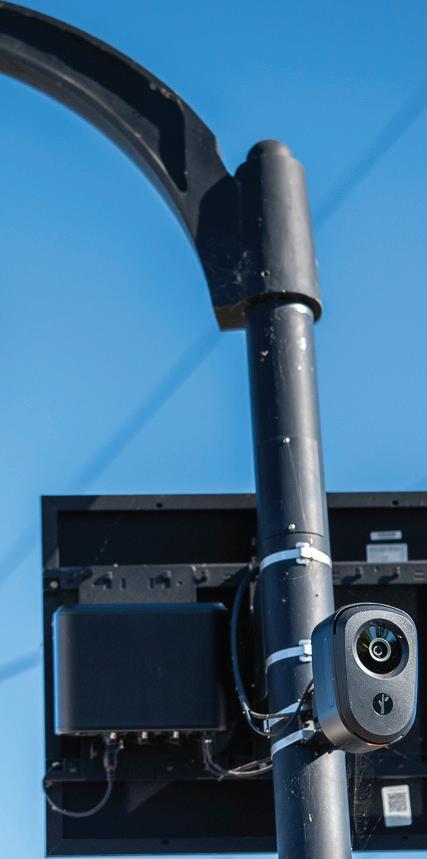
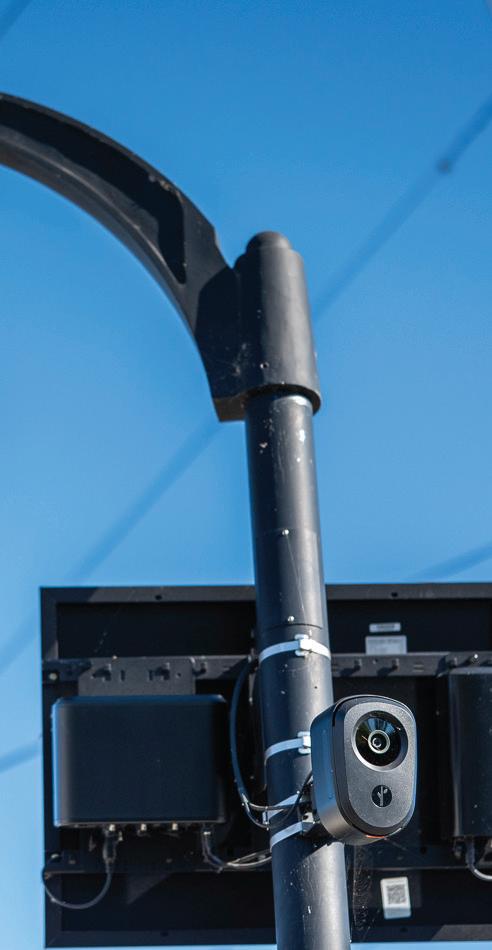

Another goal of the center is to bring in faculty from the SSWANA region that can mentor UO students and help them feel more connected to the community.
“Having something that you can touch and hold and meet people within, I think is really important because there are clubs of course but there is so much beauty in art and the culture and the languages of the SSWANA region and that needs to be held in a physical space,” Patel said.
The center was formed from a partnership with over a dozen UO clubs but it is not a club itself, instead being held under administrative control through the Multicultural Center and the Division of Student Life.
The SSWANA center is designated as a center and not just a club because people establishing the center are from several different UO clubs. These clubs include the UO Muslim Student Association, UO Arab Student Association and UO South Asian Cultural Alliance.
Dinoh Ortiz-Carté, MCC and SSWANA Center program director, called the SSWANA Center an “extension” of the broader MCC.
The MCC operates nearby in EMU room 109 and provides physical space for more than 25 student unions to meet. An Instagram post announcing the new center described the SSWANA center as a community space for stu-
dents and unions to share resources with each other.
SSWANA has collaborated with several groups on campus to host events, including a fall bazaar in collaboration with MSA, ASA and SACA, and an upcoming guest lecture with a Palestinian human rights lawyer hosted in collaboration with the Associated Student of the University of Oregon, ASA and the UO Human Rights Center Coalition.
The SSWANA center currently has four staff positions, including three student associates and one engagement fellow.
“Leading up to this process (we) had already had a conversation about supporting the process of wanting to establish a SSWANA Center and then eventually that ended up with us (MCC) being the administrative home,” Ortiz-Carté said.
An “administrative home” means that unlike other clubs that are run as ASUO student organization spaces, the SSWANA Center reports to and is funded through the MCC and ultimately through the UO Division of Student Life.
The SSWANA Center was granted the space after interested members applied through a new space allocation program, and followed up with the EMU Administrative Space Allocation and Review Committee in interviews showing their interest and goals for the space.
Jessi Steward, the chair of ASpARC, said that last spring
the committee received several applications from student organizations interested in claiming spaces in the EMU, but many did not fit the application criteria, and it was determined that SSWANA was most suitable for the opening EMU space.
“SSWANA was certainly one (group) we were really excited to work with and when we had a space available we put the recommendation forward,” Steward said. “They’ll be good stewards of the space — they will be open and have enough funding and staffing to make it a vibrant part of the EMU.”
Before SSWANA moved into room 211, the Men’s Resource Center occupied the room. The MRC is now being housed under University Health Services and is in the process of finding a more permanent home, according to UO Spokesperson Eric Howald.
A pilot program in spring 2025 introduced a system to allocate EMU space to applicants and occupants, including an application and a final decision made by the EMU’s director, Eric Alexander.
ASpARC discusses and votes on how administrative spaces are allocated. EMU spaces open for student organizations funded through ASUO are separate and open for applications on Engage.
Because the SSWANA center is funded through the Di-
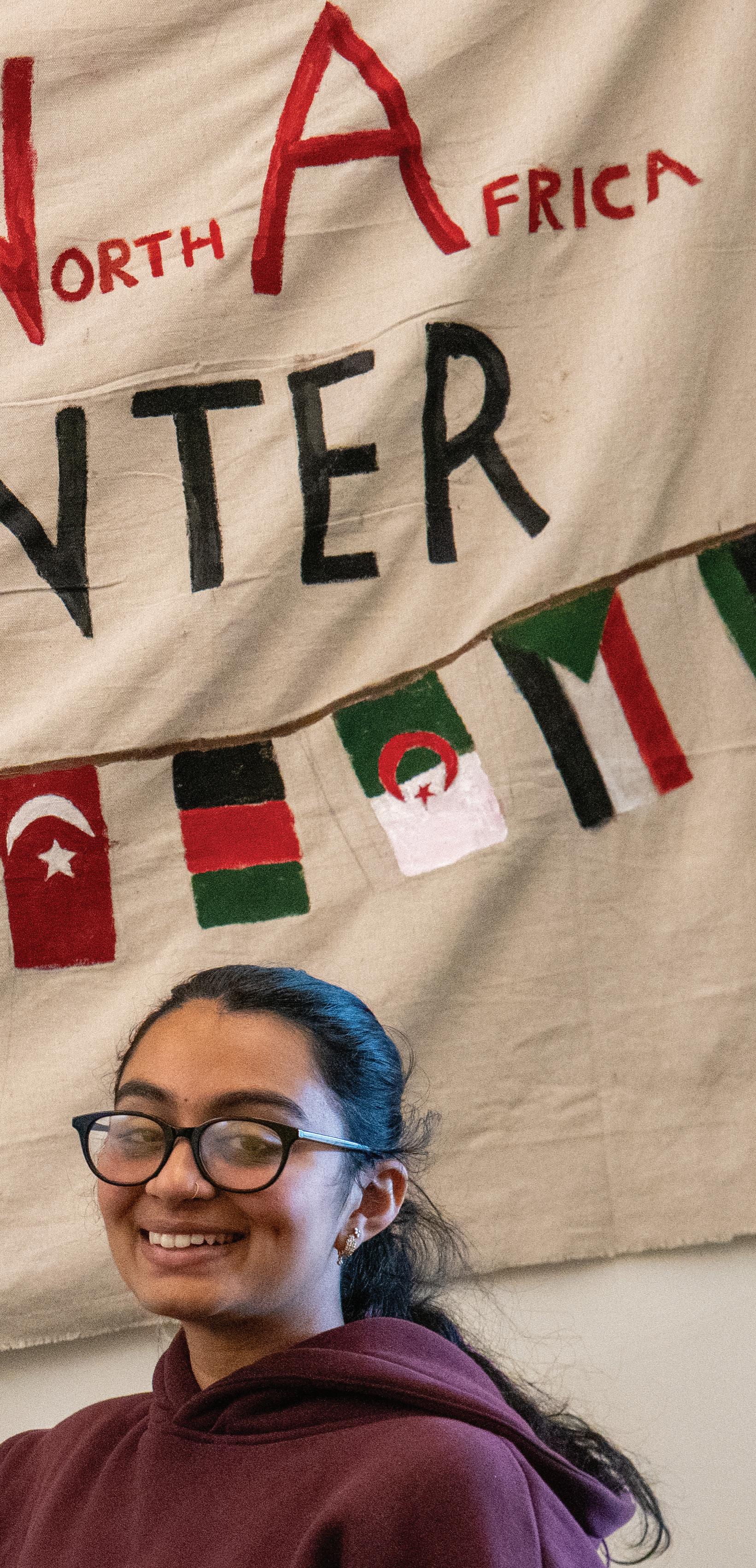
vision of Student Life, it is considered an administrative space and had to be reviewed by and voted on by ASpARC.
SSWANA was informed of its granted space in August, according to Patel.
Steward said the EMU and division of student life will continue to ensure a balance of how spaces in the EMU are allocated.
“Things will change but the mix should always be that dynamic mix where students are served,” Steward said. Patel said it was exciting that the SSWANA center offered a physical location for members to meet and learn from each other.
though they received an overwhelming response with an estimated 500 applicants. The applications were disabled shortly after the 24 hour mark, though Krause was able to raise $5,000 which were distributed to the first 100 responses.
Within the application process, individuals were able to leave a reason for needing financial assistance. Krause shared that some had lost jobs recently, while others relied on SNAP to survive month to month. They added that this issue is not existing only due to federal cuts, but also due to systemic poverty.
“Nonprofits that focus on these key systemic issues only have the staff that they have, and they only have the kitchen that they have,” Krause said. “So they’re getting sent 100s of 1000s of dollars and then, they don’t have the time, the capacity or the energy to train new staff, to find bigger kitchens or bigger spaces for these things.”
In March 2025, President Trump’s administration cut over $1 billion in funding to programs that distribute food to schools and food banks. This decision has impacted several long-standing local organizations who saw their food donations cut.
Our Streets PDX, one of the affected organizations, was founded in 2020 with the mission to address homelessness, food insecurity and youth engagement. The group’s website explains their belief that food is a “fundamental human right,” and that they are currently serving over 250 meals to homeless people daily.
Director of Communications at Our Streets PDX Winter Wagner, a University of Oregon alumni, explained that there have been notable increases in need long before SNAP cuts were announced.
“I would hope that people would recognize that this is not a one time issue,” Wagner said. “This is a chronic issue and there are a lot of nonprofits that have been addressing this for years and they are going to continue needing support.”
Lift UP, another local nonprofit, shares similar sentiments to Our Streets PDX, fighting to feed as many people as possible without direct federal funding. Stephanie Barr, Lift UP’s Executive Director, explained their goal is to address dietary needs and food insecurity in a “dignified way.”
“We have data on the folks that we serve, especially given the dietary accommodations that we make,” said Barr. “90% say that they’re better able to manage their health as a result of the access that we’re providing.”
Barr is one of nine employees at Lift UP, though they manage over 125 volunteers on a regular basis. The nonprofit serves the Portland community via premade boxes, free pantries and free food services in low income buildings.
Barr added that Lift UP has seen their client base increase by 20% each year since 2022. Regardless of the jump in need, the federal funding cuts to Oregon Food Bank reduced their deliveries by 50%, from 10,000 pounds to 5,000.
“I agree with Oregon Food Bank that hunger is a policy choice, the money is there and there are funding streams that would have fully funded it,” Barr said. “Our food systems have been broken for a long time, and they haven’t been serving our community effectively.”
Lift UP has experienced uncertainties beyond funding, as lines for their pantries change week to week, leaving the team unable to predict how many people will show up. Although Barr continued to explain that because of the overproduction of food, a lot of their donations come from Amazon Fresh and grocery stores due to high waste levels.
“Food is not really the issue, and that’s part of what’s infuriating about this, is that it’s a completely constructed crisis,” Barr said.
Barr shared that even those in need have been doing what they can to serve others, recounting that a Portland State University student donated over 250 pounds of food with their Electronic Benefit Transfer funds.
“People are doing what they can, and two thirds of the people that we serve share some of the food that they get from us, even when they’re still food insecure,” Barr said. “I think we need to be looking and putting pressure on the people that actually have the resources to do something.”

“Bugonia” interrogates alienation, as aliens would see it
A dark comedy with an otherworldly twist, Yorgos Lanthimos’s “Bugonia” hit theaters this Halloween.
By Amelia Fiore Arts & Culture Writer
*spoilers ahead
Yorgos Lanthimos, director of “The Killing of a Sacred Deer” and “Poor Th ings,” has released his latest absurdist black comedy sci-fi. “Bugonia” came to theaters nationwide on Oct. 31, and its premise has already made a lasting impression.
The story follows cousins Teddy (Jesse Plemons) and Don (Aidan Delbis) as they enact their plan to abduct CEO Michelle Fuller (Emma Stone) of pharmaceutical company Auxolith, in their attempt to expose her as an alien and save the human race.
The movie’s premise is based on the 2003 South Korean fi lm, “Save the Green Planet!” directed by Jang Joon-hwan. Joon-hwan took a spot in “Bugonia’s” writing team, alongside Ari Aster, Alicia Silverstone, Will Tracy and Lanthimos.
The script, although fi lled with funny quips, felt unnatural at times. Perhaps the awkwardness is simply a Lanthimos staple, but it creates a disconnect from the screen for moviegoers. What did work, though, was the playful jabs at modern professional candor, or “corporate speak.” The writers emphasize phrases like “let’s circle back” or “have a dialogue” that are part of that commercial, uniform script are uncanny enough to be alien.
What really makes this fi lm, though, are the commanding performances of Plemons and Stone.
Both characters do terrible things throughout the fi lm, but because of their morally gray reasoning, the audience may have a hard time casting judgement on either of them, making for a dynamic watch. Plemons’s performance is especially beautifully off-putting. The way he humanizes someone so unhinged and disconnected from reality, and even convinces the audience to conjure sympathy for him, is incredibly powerful.
The movie also features the comedian Stavros Halkius as clueless cop Casey and the talented Silverstone as Teddy’s ill, conspiracy theorist mom Sandy. In a flashback, we see that Sandy, whose coma was caused by an Auxolith medical experiment, influenced Teddy’s view on those in power and used her illness to fuel his distrust.
Currently, “Bugonia” holds a 7.7/10 rating on IMDb and has reported a domestic box office gross of nearly $7.6 million, earning an estimated $4.4 million from its opening weekend alone, the highest opening numbers Lanthimos has seen in his career.
And people’s excitement for this fi lm makes sense. What began as a blatant metaphor for the destructive, exploitative nature of modern capitalism began to weave itself through other contexts. In Teddy’s attempt to save humanity, he, because of his flawed human feelings, accidentally unveils the exact reason it shouldn’t be saved.
At face value, “Bugonia” is a fi lm about aliens. Its deeper message is about alienation, and how conspiracy theories and other internet rabbit holes tear people fatally far from reality. But even past that, it’s about the worth of humanity, and how we attach productivity to our success as a species. It’s a pretty on-the-nose narrative without a call to action, perfectly anxiety-inducing with no proposed cure.
Lanthimos imagines how aliens would see us — a species consumed by a culture of greed and violence. But the fi lm also asks the viewer to consider if there is some good left in the world, whether in the face of corporate corruption or an alien invasion. Prepare to walk out of the theater incredibly entertained, if not consumed with a hint of dread.



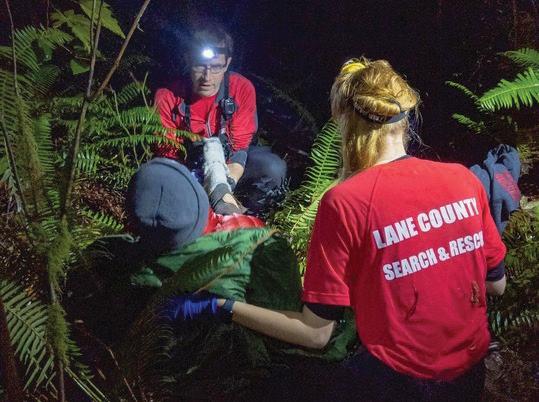
Midway through fall term, many students are excited to get outside. Hear from Lane County Search and Rescue volunteers on how to stay safe while exploring in nature.
By Gigi Roddick Arts & Culture Writer
As the leaves change color in Eugene, people look to the outdoors for crisp weekend walks, mushroom foraging opportunities and hot springs camping getaways.
No matter the size or shape of the adventure, always prepare for the unexpected before heading out. Fail to do so and you might find yourself calling on Lane County’s Search and Rescue team.
Approximately 200 volunteers make up the organization tasked with responding to reports of injured and missing people.
Ground SAR teams work to canvas physical terrain by foot, sometimes in tandem with specialty vehicle, horse, rescue dog and rope teams.
Joe Swinehart, a research assistant at UO, has been working with Lane County’s GSAR for two years. Swinehart said the unpredictability of shoulder season weather is a main concern for people caught unprepared. Summer and winter have fairly well established dress codes, but the hour-by-hour shifts of spring and fall make it harder to plan ahead.
“Dressing in layers so you can adjust to (the weather is) key, especially in the fall,” Swinehart said.
A whistle is another underrated necessity — people can typically only yell for help for a few hours before their vocal cords give out. “As long as you can breathe you can whistle,” Swinehart said.
Radek Aster, a former software engineer now volunteering with GSAR, cites adventurers’ desire for complete independence as potentially problematic.
“Many young people who end up having to call for help simply believe bad things won’t happen to them,” Aster said. “You
want to go adventuring and you don’t want anyone to know where you are.”
When missing subjects don’t leave behind details of their trip plans, SAR’s job gets harder.
“Let somebody know what trailhead (you are) going to and when (you) think you’ll be back,” Swinehart said. “Should anything go wrong on your trip, SAR will have a place to start looking.”
Carrying maps is essential to staying oriented and on-trail. Digitally, ensure maps are downloaded and phone batteries are charged. Keep physical maps in plastic bags to protect them from the elements. In the event you do get lost, having a satellite communication device like a Garmin or SpotX means you can alert search and rescue teams and provide your GPS location.
SAR’s work extends far beyond just canvassing and extracting people lost in the wilderness, though. They are also responsible for supporting criminal investigations through evidence collection, disaster response and wilderness medical aid.
“Some of the things we do are really ugly,” Swinehart said.
He is referencing recovery calls where subjects are presumed to be deceased. Suicides and body extractions can be the harsh reality of SAR’s work.
But, a love of the outdoors and dedication to community service motivates volunteers to show up even in the rougher moments.
“If you’re looking to be part of something bigger, you don’t have to join the military. Join SAR,” Aster said.








1 Enemy, in modern slang
Price of admission
Word after gray or play
Where an affectionate pet may rest
University of Cincinnati team
Kids’ online game known for Adopt Me! and Dress to Impress
Perform a Suplex or Half Nelson, maybe (Southern dialect spelling)
The underdogs at sports events, usually
Cumulative gambling tactic 4 Superfood unit similar to chia
“___ and leave no crumbs”
Mini-LPs
“___a, Kad___a, Alakazam!”
where you

Oregon volleyball records second win over UCLA in 2025 in four sets at Matthew Knight Arena
Read story online at Dailyemerald.com
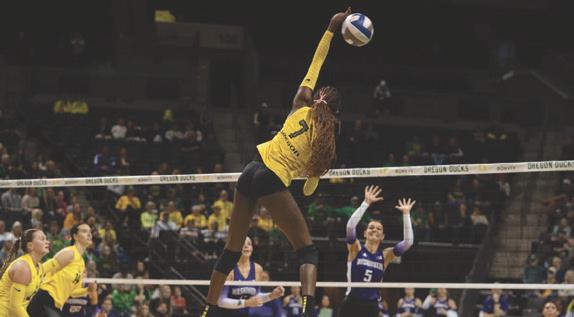
After a solid performance against Wisconsin, Thomas takes over the backup quarterback spot.
Read story online at Dailyemerald.com
Every Ducks player who saw action scored in their first win of the season.
By Joe Krasnowski Sports Writer
Th is was the desire last spring, when head coach Kelly Graves assembled parts of his roster to prepare it for any possibility in a long women’s basketball season.
Sometimes, a player is sidelined by injury. Another is limited by foul trouble. A third is having an off night.
No matter what happened, or who was doing what, Or-
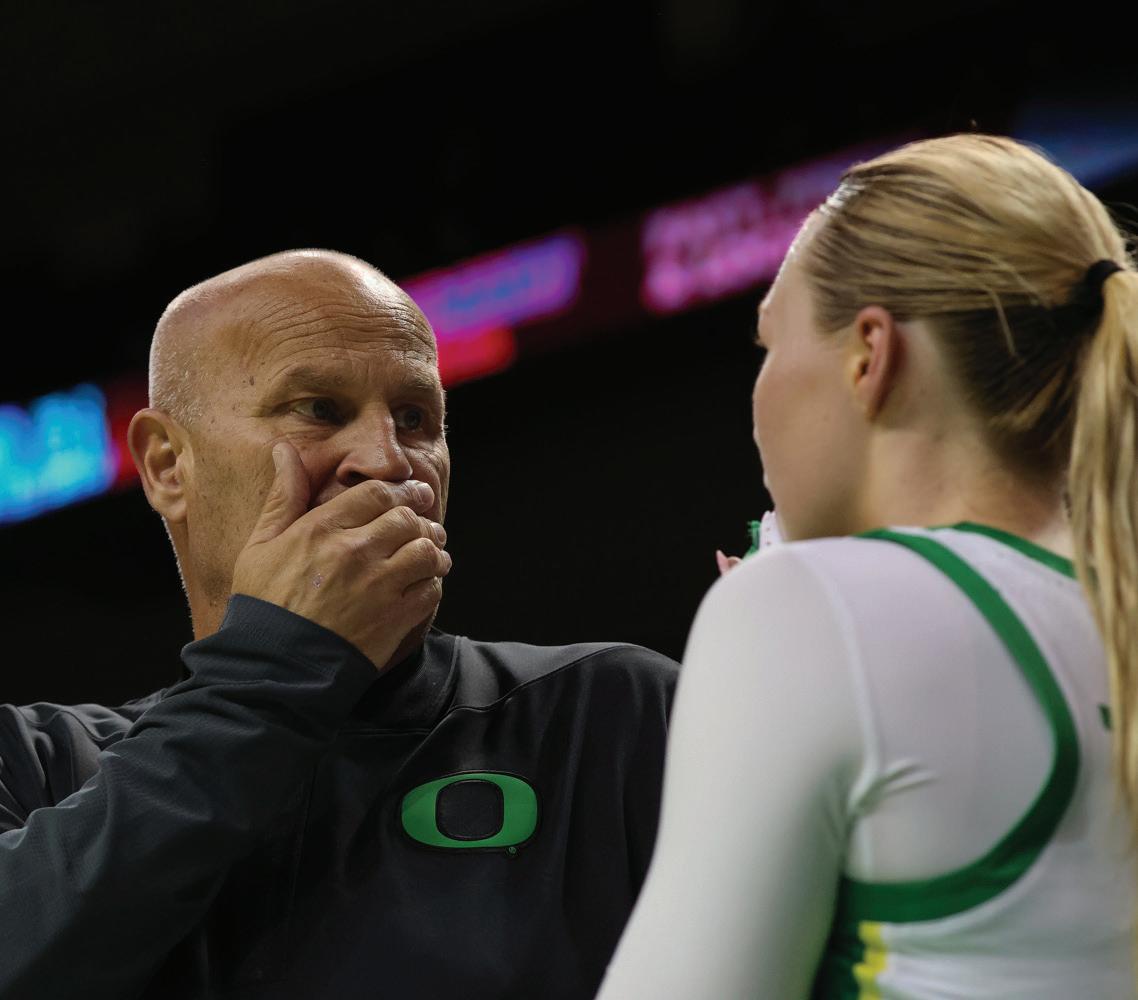
egon women’s basketball would have ample players who could get the job done.
And if everyone happened to play well on the same night? Well, that’s just a bonus.
Oregon enjoyed that sort of celebration in its season-opening Monday night win, with the Wolves being little competition for a bigger, faster, tougher Oregon team. Mia Jacobs and Elisa Mevius each had 16 and 15 points apiece for a Ducks team whose effort and intensity were the only things slowing itself down in a clear blowout.
Even for a fi rst game of the season against a far-travelled, far less talented team, this game was lopsided. Oregon had 28 points off turnovers, shot 46% from the field and might have outscored Western Georgia on breakaway layups off steals alone.
Defensively, the Ducks forced 32 UWG turnovers, which translated into 41 Oregon points.
Graves, however, was less pleased with his team’s overall performance, citing 29 third quarter points and late offensive sloppiness as a bit of a letdown overall.
“It was kind of a tale of two halves,” Graves said to begin his postgame remarks. “The fi rst half I thought we did a really good job defensively in a lot of ways, and we made it difficult, and then we kind of forgot in the second half that we have to play on that end of the floor.”
Some forgiveness, however, may be in order for a team that led 48-13 at the half and held UWG to just three points in the second quarter.
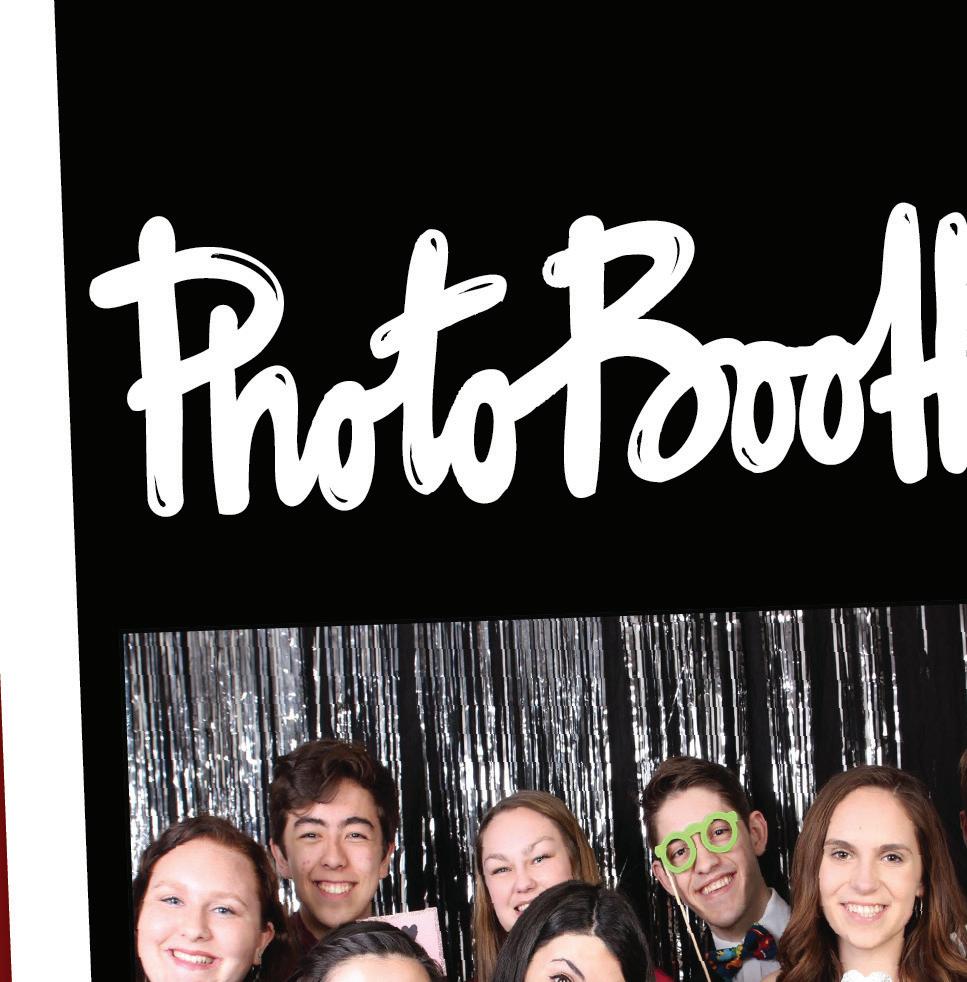
SATURDAY
Nov. 15, 2025
Oregon vs. Purdue
When playing in the half-court, the Ducks’ bevy of guards always seemed to find the open woman, with Sarah Rambus — and her silky mid-range shot — often the beneficiary. Katie Fiso had a 10-point, 10-assist double-double in just 23 minutes of action.
“I thought Katie Fiso did a great job,” Graves said. “She got us started; in the second half, she became more of a distributor, and that was nice.”
In another uplifting sign, the Ducks received excellent guard play to go with dominance from Mia Jacobs, who looked every bit the top-tier scorer that Graves expected her to be out of the portal.
“She had a nice stretch,” Graves said of Jacobs. “She’s gonna be that way, (and) she’s not a flashy player, but she’s a productive player.”
Oregon’s win was far from perfect, but a win of any kind is noteworthy in college basketball. The Ducks will take on Grand Canyon University and Army at home on Nov. 11 and Nov. 16.
(Julia Massa/Emerald)
